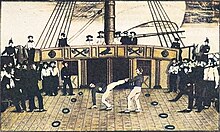Moraingy
Participation in this combat form was originally limited to young men, providing them opportunity to gain prestige and test their abilities, while allowing elders to judge their physical skills.
[4] It has since become popularized throughout Madagascar,[3] but particularly in coastal regions, and has spread to neighboring Indian Ocean islands including Réunion, Mayotte, Comoros, Seychelles and Mauritius.
[5] Although moraingy is primarily concentrated in the coastal regions of Madagascar where it was historically popularized, Malagasy migrants took the sport with them when traveling overseas.
Originally limited to the slave's quarters of the sugar plantations, in the 19th century the moringue included other ethnic groups, such as Indians and the mixed population.
[6] Moraingy matches must by tradition be accompanied by music (often salegy) to induce a trance-like state in the fighters and participants, contributing to the spiritual and communal experience of the fight.
As part of this experience, participants typically engage in dances during and between the matches that are meant to provoke the supporters of the opposing party, while the crowd cheers and jeers loudly.
According to historians, French martial art savate was brought by the sailors on their trips to the countries of the Indian Ocean and the China Sea.



